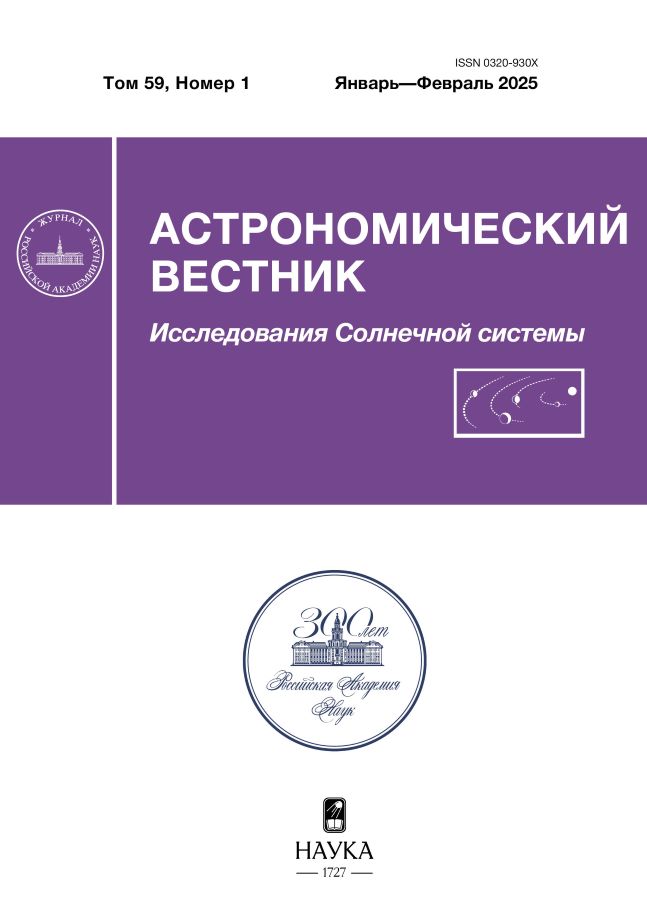Астрометрические и фотометрические исследования потенциально опасного астероида (138971) 2001 CB21
- Authors: Девяткин А.В.1, Горшанов Д.Л.1, Львов В.Н.1, Цекмейстер С.Д.1, Петрова С.Н.1, Мартюшева А.А.1, Наумов К.Н.1
-
Affiliations:
- Главная (Пулковская) астрономическая обсерватория РАН (ГАО РАН)
- Issue: Vol 59, No 1 (2025)
- Pages: 39-44
- Section: Articles
- URL: https://edgccjournal.org/0320-930X/article/view/684915
- DOI: https://doi.org/10.31857/S0320930X25010038
- EDN: https://elibrary.ru/LQFETP
- ID: 684915
Cite item
Abstract
В 2022 г. на телескопе ГАО РАН были получены астрометрические и фотометрические ряды наблюдений потенциально опасного астероида (138971) 2001 CB21 во время его сближения с Землей. На основе полученных данных и данных с сайта МРС была улучшена орбита астероида, исследованы обстоятельства сближений с Землей и Венерой и сделана оценка влияния негравитационных эффектов на его движение. По фотометрическим наблюдениям астероида была построена кривая блеска и подтвержден период его осевого вращения: Р = 3.305 ± 0.002 ч.
Keywords
Full Text
About the authors
А. В. Девяткин
Главная (Пулковская) астрономическая обсерватория РАН (ГАО РАН)
Author for correspondence.
Email: a9kin@mail.ru
Russian Federation, Санкт-Петербург
Д. Л. Горшанов
Главная (Пулковская) астрономическая обсерватория РАН (ГАО РАН)
Email: a9kin@mail.ru
Russian Federation, Санкт-Петербург
В. Н. Львов
Главная (Пулковская) астрономическая обсерватория РАН (ГАО РАН)
Email: a9kin@mail.ru
Russian Federation, Санкт-Петербург
С. Д. Цекмейстер
Главная (Пулковская) астрономическая обсерватория РАН (ГАО РАН)
Email: a9kin@mail.ru
Russian Federation, Санкт-Петербург
С. Н. Петрова
Главная (Пулковская) астрономическая обсерватория РАН (ГАО РАН)
Email: a9kin@mail.ru
Russian Federation, Санкт-Петербург
А. А. Мартюшева
Главная (Пулковская) астрономическая обсерватория РАН (ГАО РАН)
Email: a9kin@mail.ru
Russian Federation, Санкт-Петербург
К. Н. Наумов
Главная (Пулковская) астрономическая обсерватория РАН (ГАО РАН)
Email: a9kin@mail.ru
Russian Federation, Санкт-Петербург
References
- Виноградова Т.А., Железнов Н.Б., Кузнецов В.Б., Чернетенко Ю.А., Шор В.А. Каталог потенциально опасных астероидов и комет // Тр. ИПА РАН. 2003. Вып. 9. 219 c.
- Девяткин А.В., Канаев И.И., Кулиш А.П., Рафальский В.Б., Шумахер А.В., Куприянов В.В., Бехтева А.С. Автоматизация астрономических наблюдений на ЗА-320. II // Изв. ГАО. 2004. № 217. С. 505–530.
- Девяткин А.В., Горшанов Д.Л., Куприянов В.В., Верещагина И.А. Программные пакеты “Апекс-I” и “Апекс-II” для обработки астрономических ПЗС-наблюдений // Астрон. вестн. 2010. Т. 44. № 1. С. 74–87. (Devyatkin A.V., Gorshanov D.L., Kouprianov V.V., Vereshchagina I.A. APEX I and APEX II software packages for the reduction of astronomical CCD observations // Sol. Syst. Res. 2010. V. 44. № 1. P. 68–80.) https://doi.org/10.1134/S0038094610010090
- Львов В.Н., Цекмейстер С.Д. Использование программного пакета ЭПОС для исследования объектов Солнечной системы // Астрон. вестн. 2012. Т. 46. № 2. С. 190–192. (L'vov V.N., Tsekmeister S.D. The use of the EPOS software package for research of the Solar System objects // Sol. Syst. Res. 2012. V. 46. № 2. P. 177–179.) https://doi.org/10.1134/S0038094612020074
- Мартюшева А.А., Петров Н.А., Поляхова Е.Н. Численное моделирование воздействия светового давления на движение астероидов, в том числе сближающихся с Землей // Вестн. СПбГУ. 2015. Сер. 1. Т. 2 (60). Вып. 1. С. 135–147.
- Панасенко А.И., Чернетенко Ю.А. Моделирование влияния эффекта Ярковского на движение астероидов // Тр. ИПА РАН. 2014. Т. 31. С. 59–65.
- Colazo M., Scotta D., Monteleone B., Morales M., Ciancia G., García A., Melia R., Suárez N., Wilberger A., Fornari C., and 4 co-authors. Asteroid photometry and lightcurve analysis for six asteroids // Minor Planet Bull. 2022. V. 49. P. 304–306.
- Fornas G., Fornas A., Mas V. Nine Main belt asteroids, one near-Earth, and two potentially hazardous asteroid lightcurves // Minor Planet Bull. 2022. V. 49. P. 196–199.
- Galád A., Pravec P., Kušnirák P., Gajdoš Š., Kornoš L., Világi J. Joint lightcurve observations of 10 Near-Earth asteroids from Modra and Ondřejov // Earth, Moon, and Planets. 2005. V. 97. P. 147–163. https://doi.org/10.1007/s11038-006-9066-x
- Krasinsky G.A., Pitjeva E.V., Vasilyev M.V., Yagudina E.I. Hidden mass in the asteroid belt // Icarus. 2002. V. 158. P. 98–105. https://doi.org/10.1006/icar.2002.6837
- Mueller M., Delbo M., Hora J.L., Trilling D.E, Bhattacharya B., Bottke W.F, Chesley S., Emery J.P., Fazio G., Harris A.W., and 7 co-authors. Explore NEOs. III. Physical characterization of 65 potential spacecraft target asteroids // Astron. J. 2011. V. 141. № 4. 9 pp. https://doi.org/10.1088/0004-6256/141/4/109
- Scargle J.D. Studies in Astronomical Time Series Analysis. II. Statistical Aspects of Spectral Analysis of Unevenly Spaced Data // Astrophys. J. 1982. V. 263. P. 835–853.
- Usui F., Kuroda D., Müller T.G., Hasegawa S., Ishiguro M., Ootsubo T., Ishihara D., Kataza H., Takita S., Oyabu S., Ueno M., Matsuhara H., Onaka T. Asteroid catalog using AKARI: AKARI/IRC mid-infrared asteroid survey // Publ. Astron. Soc. Japan. 2011. V. 63. P. 1117–1138. https://doi.org/10.1093/pasj/63.5.1117
- Vokhrouhlický D. A complete linear model for the Yarkovsky thermal force on spherical asteroid fragments // Astron. and Astrophys. 1999. V. 344. P. 362–366.
- Vokhrouhlický D., Milani A., Chesley S.R. Yarkovsky effect on small near-Earth asteroids: Mathematical formulation and examples // Icarus. 2000. V. 148 (1). P. 118–138. https://doi.org/10.1006/icar.2000.6469
- Warner B.D., Stephens R.D. Near-Earth asteroids lightcurve analysis at the center for Solar System studies: 2022 February-March // Minor Planet Bull. 2022. V. 49. P. 176–179.
- Gaia Archive web-page: https://gea.esac.esa.int/archive/MPC
- web-page: https://minorplanetcenter.net/db_search/ show_object?object_id=138971
- MPC web-page 2: https://minorplanetcenter.net/iau/MPCORB.html
Supplementary files













